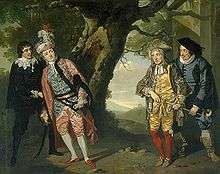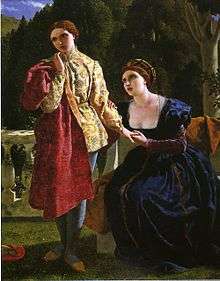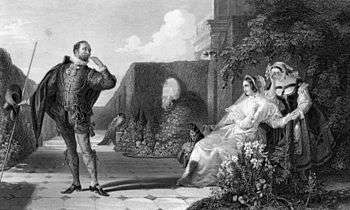Viola (Twelfth Night)
| Viola | |
|---|---|
 Francis Wheatley painted the character Viola preparing to duel, circa 1771 | |
| Creator | William Shakespeare |
| Play | the Twelfth Night |
| Source | Twelfth Night |
| Other name(s) | Cesario |
| Family | Sebastian (twin brother) |
| Role | Main Character |
Viola (pronounced \ˈvaɪoʊlə\) is the heroine[1] and protagonist of the play Twelfth Night, written by William Shakespeare.[2]
Viola's actions produce all of the play's momentum. She is a young woman of Messaline, a fictional country invented by Shakespeare, although some believe that this country really did exist.[3] In the beginning Viola is found shipwrecked on the shores of Illyria and separated from her twin brother, not knowing whether he is alive or dead, the Sea Captain that tells her that this place is ruled by the Duke Orsino, who is in love with the Countess Olivia. Viola wants to serve her, but, finding this impossible, she has the Sea Captain dress her up like a eunuch, so she can serve the Duke instead.
Viola chooses the name Cesario and secures a position as a page working for the Duke. He then entrusts Cesario (Viola) to express his love for Olivia.[4] Cesario continues to pass messages back and forth between the Duke and Olivia, but this eventually places her in somewhat of a quandary: she is forced by duty to do her best to plead Orsino’s case to Olivia, but an internal conflict of interest arises when she falls in love with Orsino, and Olivia, believing her to be male, falls in love with her. Upon receiving a ring from Olivia's steward, Viola contemplates the love triangle her disguise has created, admitting only time can solve it.
When Sebastian, Viola's lost twin, arrives alive and well in Illyria with a pirate named Antonio, the chaos of mistaken identity ensues. The absurdity of the identity crisis builds until Sebastian and Viola as Cesario meet for the first time, and eventually recognize one another. Olivia and Sebastian have already been secretly married, as she mistook him for Cesario, and Sebastian, ignorant of the foregoing love triangle, was simply entranced by a beautiful woman. Ultimately then, given what he has witnessed, Orsino admits that he will no longer pursue Olivia, agreeing to love her as his sister, and decides to take Viola as his wife once she quits her disguise.
Although Viola is the play's protagonist, her true name is not spoken by any character—including herself—until the final scene of the play (Act 5, scene 1).
Art and stage depictions
Circa 1771 Francis Wheatley used actress Elizabeth Younge as a model to paint Viola in Act III, Scene 4 after she and Sir Andrew have drawn swords (painting top-right).[5]

William Hamilton painted the confrontation between Olivia and Viola circa 1797: in Act V, Scene 1 Olivia believes Viola (dressed as Cesario) to be Sebastian (Viola's twin brother) who she has just married. After Viola denies any knowledge, incredulous Olivia asks the priest to confirm they were married just two hours prior.[6]
Walter Howell Deverell used model Elizabeth Siddal in his 1850 painting, showing Viola as Cesario looking longingly at Duke Orsino.[7]


In the mid-19th century Frederick Richard Pickersgill painted a few scenes, including: in Act 1, Scene 4 after the character Viola is shipwrecked, when she cross-dresses as Cesario, enters the service of Duke Orsino as his page and falls in love with him; and in Act 3, Scene 1 when Olivia declares her love for Cesario (1859 painting).[8]

In the 20th century German actress Lucie Höflich played Viola in Was ihr wollt (Twelfth Night in German) at the Deutsches Theater in Berlin.[9]
Tallulah Bankhead played Viola in a 1937 radio broadcast of the play.[10]
Eddie Redmayne made his professional stage debut as Viola for Shakespeare's Globe at the Middle Temple Hall in 2002.[11]
In 2009, Anne Hathaway played Viola in the Shakespeare in the Park's production of "Twelfth Night" in New York's Central Park, directed by David Sullivan.
Film representations
Twelfth Night (1910) – Directed by Eugene Mullin – Viola: Florence Turner
Twelfth Night (1937) – Director N/A – Viola: Dorothy Black
Twelfth Night (1939) – Directed by Michel Saint Denis – Viola: Peggy Ashcroft
Twelfth Night (1957) [TV] – Directed by David Greene – Viola: Rosemary Harris
Twelfth Night (1957) – Directed by Caspar Wrede – Viola: Dilys Hamlett
Twelfth Night (1969) – Directed by John Sichel – Viola: Joan Plowright
Twelfth Night (1974) – Directed by David Giles – Viola: Janet Suzman
Twelfth Night (1980) [TV] – Directed by John Gorrie – Viola: Felicity Kendal
Twelfth Night (1987) – Directed by Neil Armfield – Viola: Gillian Jones
Twelfth Night or What You Will (1988) - Directed by Kenneth Branagh of the Royal Shakespeare Company/produced for television by Thames Television Ltd. - Viola: Frances Barber
Twelfth Night, or What You Will (1988)– Directed by Paul Kafno – Viola: Frances Barber
Twelfth Night (1992) - [Animated Tales] – Directed by Mariya Muat – Viola: Fiona Shaw
Twelfth Night (1996) - Directed by Trevor Nunn – Viola: Imogen Stubbs
Twelfth Night, or What You Will (1998) [TV] – Directed by Nicholas Hytner – Viola: Helen Hunt
Twelfth Night, or What You Will (2003) – Directed by Tim Supple – Viola: Parminder Nagra
References
- ↑ O'Connor, Evangeline Maria (ed.). Introduction to Shakespeare's Viola from Twelfth Night (from The Works of William Shakespeare, Volume 16). J.D. Morris and Co. Retrieved April 1, 2015.
- ↑ Garzanti, Aldo (1974) [1972], Enciclopedia Garzanti della letteratura (in Italian), Milan: Garzanti, p. 688
- ↑ Viola (fictional character), enotes.com, retrieved 2009-05-12
- ↑ http://absoluteshakespeare.com/guides/twelfth_night/summary/twelfth_night_summary.htm
- ↑ Shakespeare Illustrated, Emory University, 2003, retrieved 2009-05-12
- ↑ Shakespeare Illustrated, Emory University, 2003, retrieved 2009-05-12
- ↑ Walter Howell Deverell, Twelfth Night (1850), Emory University, 2003, retrieved 2009-05-13
- ↑ Frederick Richard Pickersgill, Viola and the Countess (1859), Emory University, 2003, retrieved 2009-05-12
- ↑ Bundesarchiv - Picture database: Picture archive (in German), retrieved 2009-04-14
- ↑
- ↑ "Eddie Redmayne: The darling of the Donmar is making tracks into Hollywood". The Independent. 7 January 2010. Retrieved 6 March 2015.
External links
![]() Media related to Viola (Twelfth Night) at Wikimedia Commons
Media related to Viola (Twelfth Night) at Wikimedia Commons
